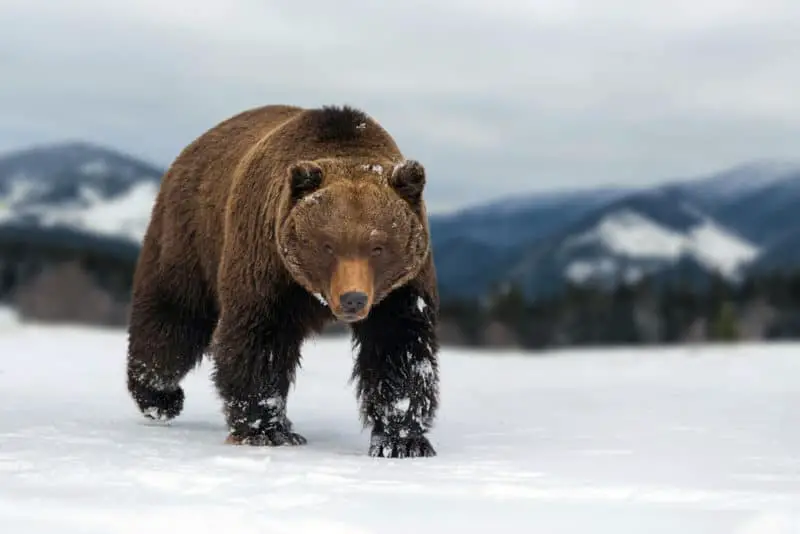Today grizzlies have been expatriated from 98% of their original habitat in the contiguous 48 states. However, there are still some remaining areas in the United States that have grizzly bears. To be more exact, Alaska, Washington state, Idaho, Montana, and Wyoming all have grizzly populations. There’s also a very remote chance that there are grizzlies in Colorado. However, the last known grizzly bear there died in 1979. The state with the most grizzly bears is Alaska, while in the contiguous United States, Montana has the largest grizzly population.
Grizzly bears are the North American subspecies of the brown bear. Because of habitat loss and the fact that they are just not compatible with a lot of human interaction, there are a lot fewer grizzly bears around than there were in the 1800s. Grizzly bear range once extended from central Mexico north through the western half of the United States and up through western Canada to Alaska and northern Canada.
There are between 2,000 and 2,200 grizzly bears in the contiguous United States and an additional 30,000 of them in Alaska. For comparison, there are around 200,000 black bears in the contiguous United States and another 100,000 of them in Alaska.
Since 1975, grizzly bears in the contiguous United States have been listed as a threatened species under the endangered species act. This gives the U.S. Fish and Wildlife Service the ultimate authority to make management decisions on their behalf.
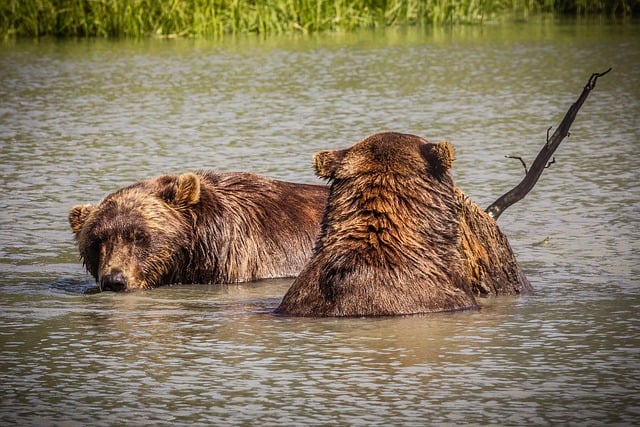
Grizzlies in Alaska
According to the Alaska Department of Fish and Game website, the state is home to an estimated 30,000 grizzly bears. This number reflects the population of coastal brown bears as well as the population of grizzlies from the interior areas. Brown bears and Grizzlies are from the same species, “Ursus arctos”. On the other hand, inland grizzly bears are a subspecies of brown bear with a scientific name of “Ursus arctos horribilis”. To my way of thinking, this means that grizzly bears are brown bears, but brown bears are not necessarily grizzly bears. However, for the purpose of this article, we’ll consider the terms brown bear and grizzly bear as interchangeable.
Inland Grizzlies
Adult male inland grizzlies weigh 400 to 790 pounds while females weigh 290 to 400 pounds. Source. These bears range in color from light tan to dark brown and have a grizzled sprinkling of silver hair on their hump and shoulders. Additionally, grizzlies have dished out faces and a large hump on their shoulders. The presence or lack of a shoulder hump is a good indication of whether you’re looking at a grizzly or a large black bear.
Alaska Peninsula Brown Bear
In Alaska, the Alaska Peninsula brown bear or peninsular grizzly is a generic term for bears that live in the state’s coastal areas. This includes but is not limited to the brown bears on the Alaskan Peninsula. They also live in coastal British Columbia. Male Peninsular Grizzlies average around 900 pounds in weight while females average around 500 pounds. However, extremely large males weigh up to 1500 pounds. Source The extreme size of these animals is thought to be partially influenced by their environment. This is due to the fact that they live in areas with an abundant supply of food.
Kodiak Brown Bear
The Kodiak bear, which is also called the Alaskan brown bear, inhabits the islands of the Kodiak Archipelago in Alaska. Peninsular grizzlies are large. However, Kodiak bears are larger still. Kodiaks are the largest of the brown bears. They’re also among the largest bears on the planet.
The largest Kodiak bears are equal to the largest polar bears in size. Mature male Kodiak Brown bears range from 1,052 to 1,177 pounds in size, while the females average 20% smaller. The largest Kodiak males weigh in at over 1500 pounds and rival polar bears for length and mass.
Since they have such a robust population, Grizzlies in Alaska do not have the same federal protections under the endangered species act that they do in the lower 48 states.
Besides grizzlies, Alaska is home to 2 other species of bears in the polar bear and the American black bear.
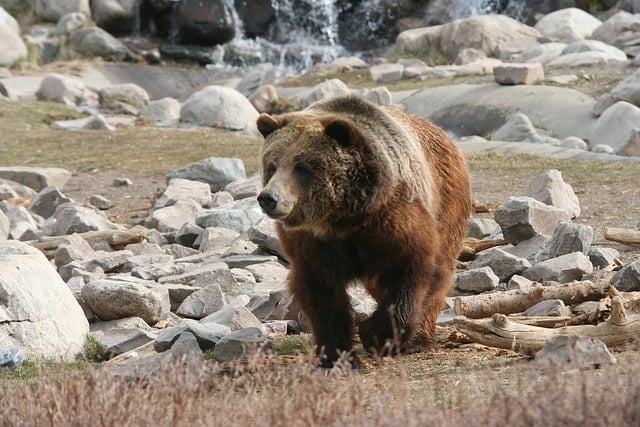
Grizzly Bear Population In Montana
Montana’s grizzlies and all other grizzly bears that live in the continental U.S are inland grizzly bears. See their description in the section on Alaska’s Grizzly bears.
Most Montana, Grizzly bears live in two main population centers. The first one resides in the Greater Yellowstone ecosystem. The second major grizzly bear population is in the area of the northern continental divide, which is in northwest Montana.
Greater Yellowstone Ecosystem
The greater Yellowstone ecosystem has Yellowstone national park at its heart. However, it is nearly 10 times larger than the park itself, with interconnected wildlands in Montana as well as parts of Wyoming and Idaho.
As the Grizzly bear population expands in the greater Yellowstone ecosystem, there have been increasing instances of human-bear conflicts. Grizzlies don’t coexist well with human civilization and vice versa. The GYE is surrounded by ranching country, and grizzly predation on livestock is a problem. Bears can also become habituated to human food items and garbage. Bears that are habituated to human food and garbage are more likely to cause human injury.
The grizzly bear population in the GYE has fulfilled the U.S. Fish and Wildlife Service’s numerical goals. Consequently, the states of Montana, Wyoming, and Idaho have increasingly lobbied the federal government to turn GYE grizzly bear management over to their respective states. See
To this end, in 2007, the U.S. Fish and Wildlife Service removed grizzly bears in the GYE from federal protection and turned their management over to the states. However, in 2009 a federal judge overturned the decision of the USFWS, insinuating that they had not adequately taken into consideration the potential decline in numbers of white bark pine within the ecosystem. Whitebark pine nuts have a high-fat content and are a major component of GYE grizzly bear’s diets.
Again in 2017, the U.S Fish and Wildlife Service removed the grizzly bears that live in the greater Yellowstone ecosystem from the threatened species list. They stated their belief that the habitat had reached its carrying capacity. Additionally, they stated that the grizzly population had sufficiently recovered to turn their management back to the individual states and Indian tribes. Ryan Zinke, who was then secretary of the interior, lauded the move as “one of America’s great conservation successes; the culmination of decades of hard work and dedication on the part of the state, tribal, federal and private partners.”
The delisting of the GYE grizzly bear was once again short-lived. In 2018 a U.S. district judge overruled the authority of the U.S. Fish and Wildlife Service to make science-based management decisions by once restoring federal protection to GYE grizzlies.
As of NOVEMBER 18, 2021, partially due to modifying the way they count the bears, biologists that keep track of the grizzly bear population in the greater Yellowstone ecosystem estimate that their population has expanded to over 1000 bears.
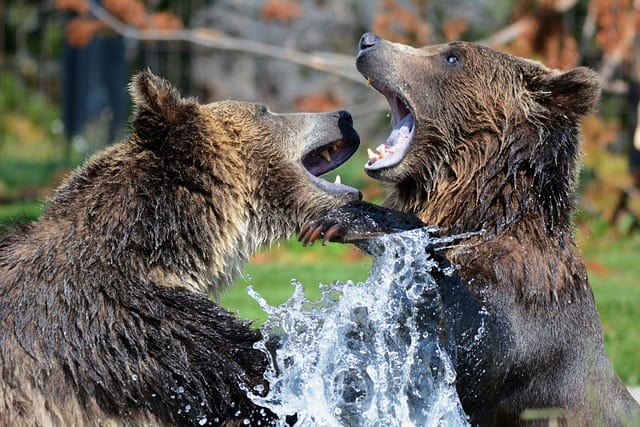
Northern Continental Divide
The Bob Marshall wilderness complex consists of the Bob Marshall, Scapegoat, and Great Bear wilderness areas. Together they take in over 1.5 million acres of pristine wilderness in the northern continental divide section of northwest Montana. Along with the GYE, this area has the highest population density of grizzly bears in the lower 48 states.
Glacier National Park is another one of the best places in the contiguous United States to find grizzly bears. The park lies in northwest Montana, with the Canadian border to its north and the Bob Marshall wilderness complex to its south. It is comprised of 1,583 square miles along Montana’s northern continental divide.
Besides grizzlies, other large carnivores that live in the park are black bears, gray wolves, mountain lions, coyotes, bobcats, and Canada lynx. The park also has bighorn sheep, mountain goats, moose, elk, mule deer, white-tailed deer, pronghorn, and bison.
Coming back to grizzly bears in Glacier National Park, the same problems occur that are endemic to bears in all national parks. When bears, especially grizzly bears, become habituated to human food and garbage, they become especially dangerous to humans.
Up until 1967, there were no recorded cases of a grizzly bear killing a human being within Glacier National Park. Since its inception in 1910, the park has had relatively few visitors and, thus, a relatively small chance for human/grizzly interaction.
The night of the grizzlies happened on August 13, 1967. It’s a date that lives in infamy in the history of Glacier National Park. This is due to the fact that two young women were killed in the park on that night by two different grizzly bears. Both of the offending bears had previously been conditioned to human food and or garbage.
According to the book ” Bear Attacks, Their Causes and Avoidance” by Dr. Stephan Herrero, between 1967 and 1980, grizzlies killed 9 people within Glacier, Banf, and Yellowstone National Parks. eight of the people who died were killed by bears that were habituated to human food and or garbage.
The above paragraphs are intended to illustrate that human interaction with grizzly bears can be dangerous. I am not trying to discourage the reader from enjoying the outdoors.
The National Park Service points out that your odds of being harmed by a grizzly bear while in Yellowstone Park are approximately 1 in 2.7 million. Furthermore, statistics show that you have more to fear from drowning, lightning, being burned in a geyser, or even having a tree fall on you than you do from grizzly bears in Yellowstone Park. However, the fact remains that grizzlies are big, strong, unpredictable, and dangerous.
There are things you can do to make yourself safer, such as keeping a clean camp, carrying bear spray, and sleeping in a tent. See Camping In Bear Country – Krebs Creek
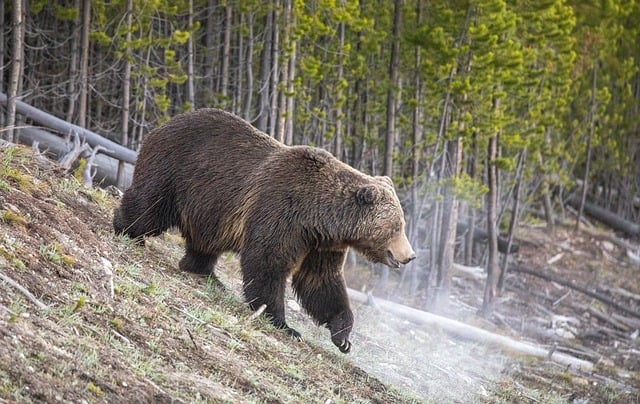
Grizzlies In Wyoming
Wyoming’s grizzly bear population is mostly concentrated in the northwestern part of the state. Ergo, this is mostly within the greater Yellowstone area. This takes in Yellowstone and Grand Teton National Park as well as the surrounding area. However, Grizzlies in Wyoming are not confined to the Greater Yellowstone ecosystem. Their home ranges go as far south as the southern ends of the Wind River and Wyoming ranges.
Grizzlies In Idaho
In Idaho, grizzly bears live mainly in the eastern and northern portions of the state. Eastern Idaho’s grizzly country is comprised of the state’s portion of the greater Yellowstone ecosystem. Besides Yellowstone National Park, the Caribou-Targhee National Forest south of Yellowstone is also home to grizzly bears.
Grizzly bears are also confirmed to inhabit the Selway-Bitterroot wilderness of east central Idaho. The Selway-Bitterroot wilderness is comprised of 1.25 million acres in the Bitterroot Mountain range. The Bitterroot mountains are on the Idaho/Montana border.
The Selkirk mountains of extreme northern Idaho and Washington have a population of grizzly bears. The Selkirk grizzly bear recovery zone is in northern Idaho but also goes over the Canadian border into southern British Columbia. The current grizzly population estimate for this area ranges somewhere between 50 and 70 bears.
The last major portion of grizzly bear habitat in Idaho that we’ll talk about is the Cabinet-Yaak Ecosystem. The Cabinet-Yaak Ecosystem takes in 2,600 square miles in northeastern Idaho and northwestern Montana. It includes the Cabinet and Purcell Mountain ranges and the Yaak River Valley.
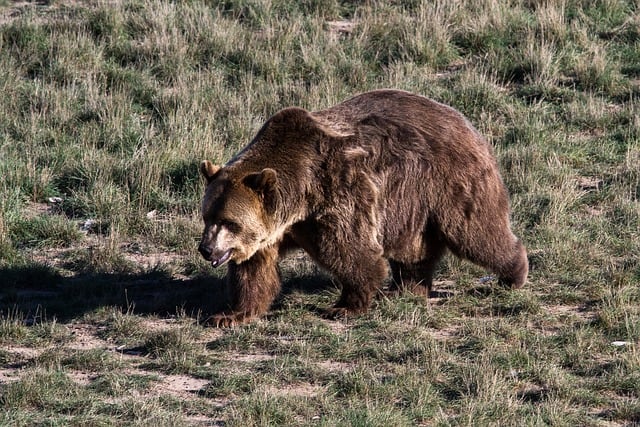
Grizzlies In Washington
According to the Washington Department of Fish and Wildlife website, in the time before European settlement, grizzly bears inhabited most of the state. However, these great bears don’t mix well with civilization. They require vast tracts of unspoiled grizzly bear habitat. The average home range for a grizzly bear is 100 to 600+ square miles. Additionally, the grizzly bear is an apex predator. They fear almost nothing. When they live close to human development, human-bear conflicts are bound to happen.
Consequently, in Washington, grizzly bears have been extirpated from the majority of their former range. There are, however, two small grizzly bear populations remaining in Washington.
The first one is in the Selkirk mountains, which Washington shares with Idaho and British Columbia.
The second grizzly bear population in Washington exists in the north Cascades. The cascade mountain range extends from northern California up through Oregon and Washington into southern British Columbia. The north Cascades offer some of the best unspoiled Grizzly habitat left on earth.
In the north Cascades in the 1800s, hunting and trapping played, coupled with a slow reproductive rate, played a large role in the reduction of the grizzly population. the population became so greatly reduced that bears had difficulty finding mates. Such a narrowing of the available gene pool makes the population less vigorous. Source
Today there are believed to be 10 to 20 grizzlies in the north Cascades and 50 to 60 grizzlies in the Selkirk grizzly recovery zone.
Grizzlies in Colorado
There’s a remote possibility that there are Grizzlies in southern Colorado. In 1979, Ed Wiseman was bow hunting elk in the San Juan Wilderness about 60 miles south of Del Norte Colorado, when he was attacked by a sow grizzly. To save his own life, he had to stab the bear to death with an arrow. Wildlife officials determined that the 400-pound sow was 20 years old. She had worn broken abscessed teeth and suffered from severe arthritis. Additionally, they determined that she had no scarring from ever having cubs.
Experts consider the Wiseman bear to be Colorado’s last grizzly. However, other experts believe that there could still be a small grizzly bear population in the San Juan mountains.
Recent Posts
The only venomous snakes in Washington State are Northern Pacific Rattlesnakes. The Northern Pacific Rattlesnake (Crotalus oreganus oreganus) is a sub-species of the Western Rattlesnake. Anyone...
Skunks are not classified as true hibernators. But they go into a state of torpor when the weather gets cold. Skunks are light sleep hibernators, along with opossums, bears, and raccoons. ...

